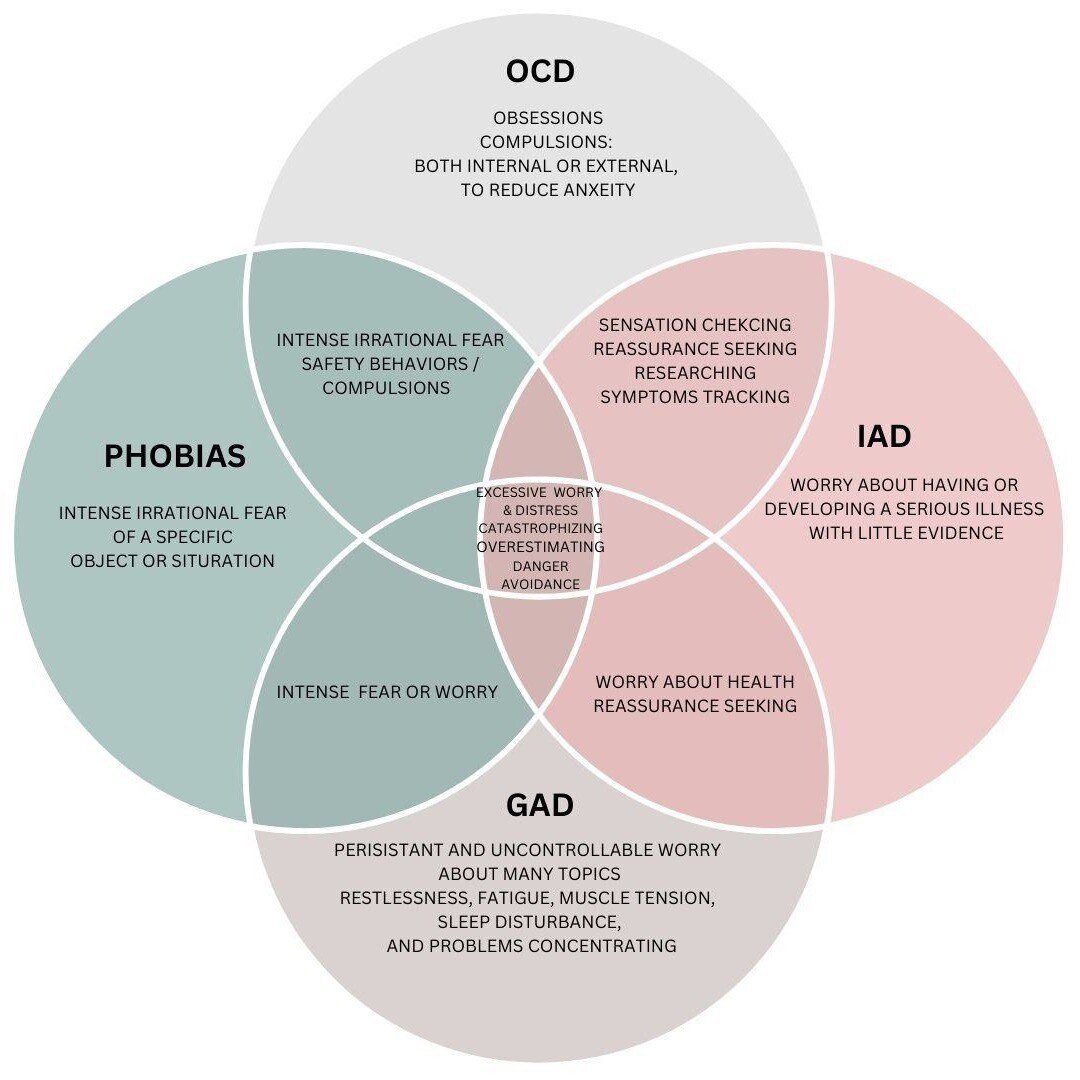ERP Therapy: Addressing OCD Misdiagnosis and Treatment
Obsessive-Compulsive Disorder (OCD) is characterized by persistent, unwanted obsessions and repetitive compulsions. According to the Diagnostic and...
7 min read
KD HOLMES, LPC, EMDR CERTIFIED, BTTI TRAINED
:
May 30, 2025 9:01:05 AM

There’s a particular kind of quiet that settles over the room when a client understands ERP and agrees to an exposure for the first time. It’s not the kind of quiet that soothes-it’s the kind that signals emotional risk. And in ERP, this kind of tension marks the start of change. Change, after all, is not without its weather.
Exposure and Response Prevention (ERP) remains the gold-standard treatment for Obsessive-Compulsive Disorder (OCD), with decades of research validating its efficacy. And yet, for many clinicians-especially those trained in models that prioritize emotional safety and symptom reduction-ERP can feel like harmful and cruel. It calls on us to take a different stance: to invite distress, not avoid it; to hold uncertainty, not resolve it; and to challenge avoidance rather than accommodate it.
If reading this is stirring discomfort, that’s not a signal to turn away-it’s an invitation. This blog is challenging you to reconsider what you think you know about change within the therapy room. It's asking you to step beyond the familiar comfort of symptom reduction and into the (sometimes messy) process of helping clients build true psychological flexibility.
We are trained to soothe, to stabilize, to protect. But what if lasting change doesn’t come from protection alone? What if it comes from helping our clients move through discomfort rather than around it? ERP invites us to shift our instincts-from alleviating anxiety to helping clients build a new relationship with it.
Discomfort in therapy, especially for the therapist, can be a sign that growth is happening. That our frameworks are expanding. That we are beginning to trust our clients’ resilience as much as we trust our own clinical instincts. So if this feels unsettling, lean in. That feeling may be the edge of your own learning curve-and right there is where the work begins.
A phrase I often use in clinical supervision is, “You’ve got to break eggs to make an omelet.” The early phases of ERP are exactly that-disruptive, disorienting, and deeply human. Perhaps that’s why I’m drawn to it. When therapy becomes a space where clients can face their most distressing fears, I want to be there. When someone does something they once believed was impossible-not because I moved the mountain, but because they discovered they could-I am honored to witness that process.
My connection to this work is personal. I know what it’s like to be consumed by anxiety, to hold intrusive thoughts so distressing that speaking them aloud feels impossible. The isolation and suffering that come with that kind of experience is profound. To help someone walk out of that darkness-it’s why I do this work.
ERP invites clients to confront their fears directly. It dismantles avoidance and replaces it with ERP experiments that cultivate psychological flexibility. These sessions can be raw and exposing, but this is often where the deepest therapeutic rapport is formed-not in spite of the discomfort, but through it.
When delivered with clarity, empathy, and effectiveness, ERP doesn’t damage the therapeutic relationship-it strengthens it. Clients learn that we can hold them accountable while also holding space for their distress. That balance-between challenge and compassion-is where meaningful change begins. And that process starts with us. It starts with our belief in their capacity. Before they believe they can do it, we have to.
Historically, ERP was grounded in habituation theory-the idea that repeated exposure to a feared stimulus leads to a natural reduction in anxiety. And while this is true for many clients, it does not account for relapse rates.
Enter Inhibitory Learning Model. This model shifts the therapeutic aim from anxiety reduction to learning. The goal is no longer comfort, but tolerance. Not "Did your anxiety decrease?" but rather, "What did you learn about your ability to be with your discomfort?"
This reframing is crucial. It allows clients to develop new associations: I can feel anxious and still act in alignment with my values. ERP becomes less about extinguishing fear and more about expanding capacity.
Inhibitory Learning has reshaped the way I practice-even beyond OCD. It has given me permission to support clients in doing hard things, with the understanding that they are not fragile but capable. It assumes resilience, not fragility. When combined with neurodiversity-affirming principles, this approach turns traditional therapy on its head. We’re not just reducing symptoms-we’re building authentic, sustainable resilience through the right kind of support.
Many clinicians enter the field with a strong inclination toward containment, grounding, and symptom relief. ERP challenges that instinct. It requires us to lean into distress-our clients’ and our own.
Research shows that therapists who lack confidence in ERP are more likely to dilute the process—terminating exposures early, avoiding variability, or softening targets. In a 2020 survey, 56% of clinicians endorsed the belief that "most clients have difficulty tolerating the distress exposure therapy evokes." And 47% endorsed that "arousal reduction strategies... are often necessary for clients to tolerate the distress exposure therapy evokes". Softening ERP produces negative outcomes. ERP being done confidently helps clients remain engaged, and they feel empowered by their results.
This is where supervision and reflective practice become vital. We must learn to differentiate between protecting our clients and protecting our own discomfort.
Interestingly, two factors predict ERP success more than symptom severity:
The client’s belief in their ability to face difficult experiences (self-efficacy)
Their willingness to stay with discomfort (distress tolerance)
This insight reshapes our approach. It tells us to prioritize behavioral momentum. Start with exposures that are real but achievable. Frame anxiety not as failure, but as a sign of movement. And whenever possible, model your own willingness to be with uncertainty.
ERP teaches clients that anxiety is not an emergency. It is a messenger. And sometimes, it’s a sign that they are engaging with what matters.
If self-efficacy strengthens ERP outcomes, what might it offer the broader therapeutic process? What if this belief-I can face hard things and get through them-is one of the core ingredients of change across all modalities? Perhaps fostering self-efficacy isn’t just a helpful strategy, but a foundational principle of successful therapy itself.
Consider a client with contamination OCD who avoids public restrooms. Habituation might suggest doing exposures while tracking SUDs before and after exposures, and doing the same exposure until SUDs is a 0.
But an inhibitory learning approach encourages variability and unpredictability with out tracking SUDs:
Use a crowded airport restroom and skip handwashing
Touch a toilet seat, then prepare and eat a meal
Watch a video of vomiting, then shake hands with someone
These exposures are not random. They target core fears through multiple pathways, reinforcing the message: I can’t control everything-but I can tolerate this distress.
Inhibitory Learning Model (ILM) broadens our therapeutic goals by shifting what we aim to reinforce. Instead of waiting for fear to disappear, we reinforce the client’s capacity to tolerate distress. The success of an exposure isn’t measured by reduced anxiety (habituation), but by increased flexibility and willingness to stay engaged in the presence of it. Here is that self efficacy again!
As therapists, we’re constantly making micro-decisions about what to reinforce. Are we siding with the distress, or with the client’s courage to face it? What if it’s both-but we let the fact that they did it be the final note we land on? Ideally, we empathize with their discomfort-and then we lean into the fact that they did the hard thing. We name it. We celebrate it. Because that’s where the learning sticks. That’s where self-efficacy builds. And that’s the kind of empathy that encourages change.
ERP can evoke strong emotions. As therapists, we worry:
These concerns are valid-and addressable.
Transparency is a cornerstone of trust-and trust is, in many ways, the foundation upon which therapeutic change is built. It's not just helpful; it’s essential.
Cultural considerations matter. ERP is flexible. We engage clients in co-creating exposures that honor their lived experience. What matters most is staying with the protocol while adapting to the individual, creating flexibility.
As therapists, we must be able to acknowledge our own uncertainty and sit with the discomfort it brings. Holding space-for ourselves and for our clients-is an essential part of delivering ERP with integrity. Strengthening our own emotional tolerance is part of the process. Below are practical tools to support us clinicians in doing just that:
ERP is not improvisation-it’s structured risk-taking, created together by you and your client.
My job today is to encourage you-new therapists stepping into ERP-to do the hard things. To take on what feels impossible. Because what if doing so doesn’t just help your clients? What if it changes you? What if facing that fear increases your own self-efficacy as a therapist and deepens your trust in this life-changing approach-one that, truthfully, we all need a little more of?
Look at the data-it’s compelling. ERP has a 60–70% effectiveness rate, making it the evidence-based intervention for treatment of OCD. That’s not just promising-that’s powerful.
ERP can feel counterintuitive. It challenges our training, evokes uncertainty, and demands clinical courage. But when done well, ERP does more than reduce symptoms. It builds lives. It creates freedom.
Our role is not to eliminate fear, but to sit with it. To help clients develop the capacity to act in its presence. To model what it looks like to stand in uncertainty without collapsing into avoidance.
ERP changes people. And when we deliver it effectively and with humanity-it changes us, too.
References
Abramowitz, J. (2018). The inhibitory learning approach to exposure and response prevention. OCD Newsletter. https://iocdf.org/expert-opinions/the-inhibitory-learning-approach-to-exposure-and-response-prevention/
Keleher, J., Jassi, A., & Krebs, G. (2020). Clinician-reported barriers to using exposure with response prevention in the treatment of paediatric obsessive-compulsive disorder. Journal of Obsessive-Compulsive and Related Disorders, 24, 100498. https://doi.org/10.1016/j.jocrd.2019.100498
Rector, N. A., Richter, M. A., Katz, D., & Leybman, M. (2019). Does the addition of cognitive therapy to exposure and response prevention for obsessive compulsive disorder enhance clinical efficacy? A randomized controlled trial in a community setting. The British Journal of Clinical Psychology, 58, 1–18. https://doi.org/10.1111/bjc.12188
Samantaray, N. N., Chaudhury, S., & Singh, P. (2018). Efficacy of inhibitory learning theory-based exposure and response prevention and selective serotonin reuptake inhibitor in obsessive-compulsive disorder management: A treatment comparison. Industrial Psychiatry Journal, 27, 53–60. https://doi.org/10.4103/ipj.ipj_35_18
Xu, J., Falkenstein, M. J., & Kuckertz, J. M. (2024). Feeling more confident to encounter negative emotions: The mediating role of distress tolerance on the relationship between self-efficacy and outcomes of exposure and response prevention for OCD. Journal of Affective Disorders, 353, 19–26. https://doi.org/10.1016/j.jad.2024.02.091

Obsessive-Compulsive Disorder (OCD) is characterized by persistent, unwanted obsessions and repetitive compulsions. According to the Diagnostic and...

For therapists, grasping the nuanced distinctions between OCD and other anxiety disorders is vital for accurate diagnosis, leading to the most...

What Do We Mean by Discomfort in Therapy? Monet:This conversation started in one of our previous talks about Exposure and Response Prevention...